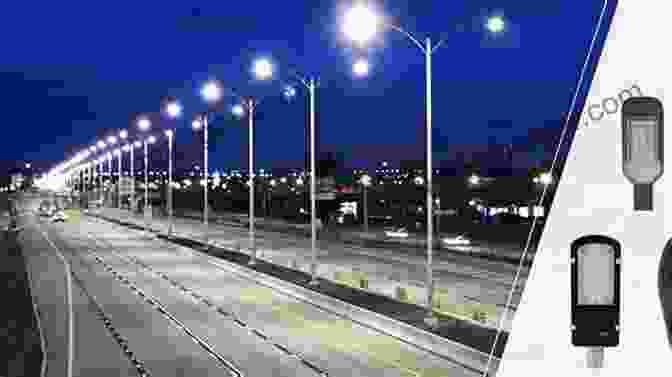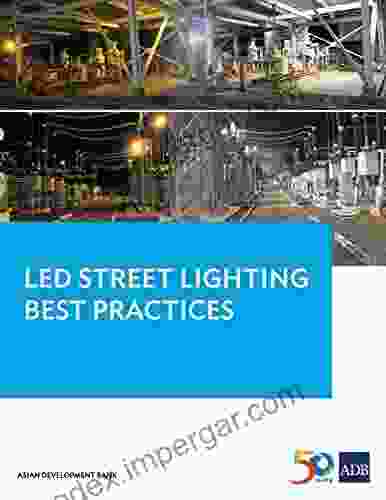Mastering the Art of LED Street Lighting: A Comprehensive Guide to Best Practices


4.4 out of 5
| Language | : | English |
| File size | : | 9360 KB |
| Text-to-Speech | : | Enabled |
| Screen Reader | : | Supported |
| Enhanced typesetting | : | Enabled |
| Word Wise | : | Enabled |
| Print length | : | 112 pages |
In the realm of urban development, LED street lighting has emerged as a transformative technology that offers unparalleled benefits in terms of energy efficiency, safety, and environmental sustainability. To harness the full potential of LED lighting, it is essential to adopt best practices that guide every aspect of its implementation and maintenance.
In this comprehensive guide, we will delve into the intricacies of LED street lighting, exploring the principles and strategies that ensure optimal performance and maximize its advantages. We will cover the entire lifecycle of LED lighting, from design and installation to maintenance and monitoring, providing valuable insights for municipalities, lighting professionals, and anyone seeking to enhance their understanding of this cutting-edge technology.
1. Design Considerations for Maximizing Impact
- Light Distribution and Optics: Understanding the specific lighting needs of different areas, such as roadways, intersections, and pedestrian crossings, is crucial for effective light distribution. The choice of optics plays a vital role in directing light where it is needed most, minimizing spill light and glare.
- Luminance and Uniformity: Ensuring appropriate light levels and uniform distribution is essential for visibility, safety, and aesthetic appeal. Proper design ensures that streets are adequately illuminated without creating areas of excessive brightness or darkness.
- Energy Efficiency and Cost Optimization: By selecting energy-efficient fixtures and optimizing light levels, municipalities can significantly reduce energy consumption and operating costs. Proper design can also leverage sensors and controls to further enhance energy savings.
- Compatibility with Existing Infrastructure: When retrofitting existing lighting systems, it is crucial to ensure compatibility with the existing infrastructure, including poles, foundations, and control systems. This requires careful planning and coordination to minimize disruption and ensure a smooth transition.
2. Installation Techniques for Reliable Performance
- Proper Pole Selection and Installation: Selecting the appropriate pole height, type, and foundation is essential for structural integrity and durability. Proper installation techniques ensure that poles are securely anchored and can withstand environmental conditions.
- Fixture Mounting and Alignment: Installing fixtures securely and aligning them precisely is critical for optimal light distribution and performance. This requires specialized tools and expertise to ensure accuracy and prevent misalignment.
- Electrical Connections and Wiring: Ensuring proper electrical connections and wiring is vital for safety and reliability. Qualified electricians should handle all electrical work, adhering to relevant codes and regulations.
- Commissioning and Testing: Before putting the lighting system into operation, thorough commissioning and testing are essential to verify proper functionality and compliance with design specifications.
3. Maintenance Strategies for Optimal Longevity
- Regular Inspections and Cleaning: Regular inspections help identify potential issues early on, allowing for prompt maintenance and repairs. Cleaning fixtures regularly removes dirt and debris, ensuring optimal light output and preventing premature failure.
- Component Replacement and Upgrades: Over time, certain components may need to be replaced, such as LED modules, drivers, or control systems. Timely replacement and upgrades ensure continued performance and safety.
- Surge Protection and Lightning Safety: Installing surge protection devices and implementing lightning safety measures is crucial to protect the lighting system from electrical surges and lightning strikes.
- Remote Monitoring and Control: Smart lighting systems with remote monitoring and control capabilities enable real-time monitoring of performance, fault detection, and remote adjustment of lighting levels, enhancing maintenance efficiency.
4. Monitoring and Evaluation for Continuous Improvement
- Light Level Measurements: Periodic light level measurements using calibrated instruments ensure that lighting levels meet the intended design specifications and are adequate for safety and visibility.
- Energy Consumption Monitoring: Tracking energy consumption allows municipalities to assess the actual energy savings achieved and identify opportunities for further optimization.
- Resident Feedback and Input: Gathering feedback from residents and stakeholders is invaluable for assessing the effectiveness of the lighting system and addressing any concerns or suggestions.
- Data Analysis and Performance Assessment: By analyzing collected data, municipalities can continuously evaluate the performance of their LED lighting systems, identify areas for improvement, and implement data-driven maintenance strategies.
LED street lighting offers a multitude of benefits, making it an indispensable solution for modern cities and communities. By embracing best practices in design, installation, maintenance, and monitoring, municipalities can harness the full potential of LED lighting. This comprehensive guide provides invaluable insights and strategies to ensure optimal performance, maximize energy efficiency, enhance safety, and create a sustainable and vibrant urban environment.
Investing in LED street lighting is not only an investment in infrastructure but also an investment in the future. By adopting best practices, municipalities can create a legacy of sustainable and efficient lighting that illuminates the path towards a brighter and more connected future for generations to come.
4.4 out of 5
| Language | : | English |
| File size | : | 9360 KB |
| Text-to-Speech | : | Enabled |
| Screen Reader | : | Supported |
| Enhanced typesetting | : | Enabled |
| Word Wise | : | Enabled |
| Print length | : | 112 pages |
Do you want to contribute by writing guest posts on this blog?
Please contact us and send us a resume of previous articles that you have written.
 Book
Book Novel
Novel Page
Page Chapter
Chapter Text
Text Story
Story Genre
Genre Reader
Reader Library
Library Paperback
Paperback E-book
E-book Magazine
Magazine Newspaper
Newspaper Paragraph
Paragraph Sentence
Sentence Bookmark
Bookmark Shelf
Shelf Glossary
Glossary Bibliography
Bibliography Foreword
Foreword Preface
Preface Synopsis
Synopsis Annotation
Annotation Footnote
Footnote Manuscript
Manuscript Scroll
Scroll Codex
Codex Tome
Tome Bestseller
Bestseller Classics
Classics Library card
Library card Narrative
Narrative Biography
Biography Autobiography
Autobiography Memoir
Memoir Reference
Reference Encyclopedia
Encyclopedia Eve Curie
Eve Curie John Hoffman
John Hoffman Bruce Cockburn
Bruce Cockburn Bruce W Winter
Bruce W Winter Michael Castille
Michael Castille C Paul Schroeder
C Paul Schroeder Brendon Burns
Brendon Burns James A Kushlan
James A Kushlan Emmy Brunner
Emmy Brunner C Paul Grandison
C Paul Grandison Jason Bailey
Jason Bailey Brenda M Coppard
Brenda M Coppard Brandon Brumage
Brandon Brumage Boyd Varty
Boyd Varty Bradley W Carroll
Bradley W Carroll Bruce Robinson
Bruce Robinson Katrina Pescador
Katrina Pescador Bruce Newman
Bruce Newman Judy Wearing
Judy Wearing E C Coleman
E C Coleman
Light bulbAdvertise smarter! Our strategic ad space ensures maximum exposure. Reserve your spot today!

 Howard PowellTravels Through Aegean Turkey: A Timeless Treasure from Henry Fanshawe Tozer
Howard PowellTravels Through Aegean Turkey: A Timeless Treasure from Henry Fanshawe Tozer Geoffrey BlairFollow ·19.8k
Geoffrey BlairFollow ·19.8k John MiltonFollow ·5.4k
John MiltonFollow ·5.4k Gustavo CoxFollow ·18.6k
Gustavo CoxFollow ·18.6k Jean BlairFollow ·5.8k
Jean BlairFollow ·5.8k Joseph ConradFollow ·4.6k
Joseph ConradFollow ·4.6k Art MitchellFollow ·13.2k
Art MitchellFollow ·13.2k George R.R. MartinFollow ·15.6k
George R.R. MartinFollow ·15.6k Terry BellFollow ·4.4k
Terry BellFollow ·4.4k

 Gary Cox
Gary CoxUnlocking Meaning and Purpose in Life: An Exploration of...
In an increasingly...

 Eric Hayes
Eric HayesMemoirs of the Early Pioneer Settlers of Ohio Illustrated
A Window into the Lives of Courageous...

 J.R.R. Tolkien
J.R.R. TolkienThe Montgomerys and Their Descendants: A Saga of Courage,...
Prepare to be...

 Avery Simmons
Avery SimmonsThe Rifle Musket: The Dawn of Modern Infantry Warfare
: The rifle musket, a revolutionary...

 Jesse Bell
Jesse BellUnlock the Power of Excel with VBA and Macros: A...
Microsoft Excel is a powerful spreadsheet...
4.4 out of 5
| Language | : | English |
| File size | : | 9360 KB |
| Text-to-Speech | : | Enabled |
| Screen Reader | : | Supported |
| Enhanced typesetting | : | Enabled |
| Word Wise | : | Enabled |
| Print length | : | 112 pages |












